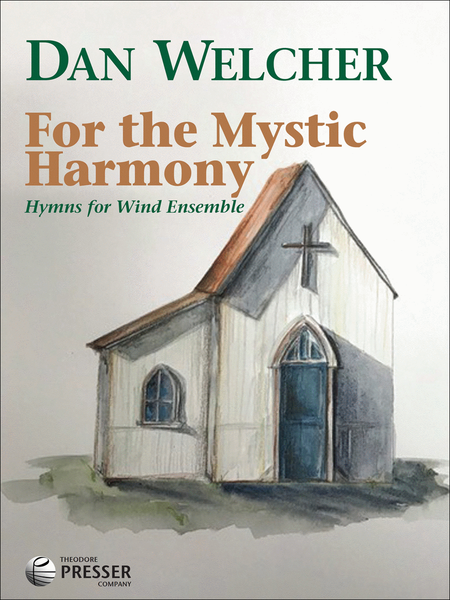For the Mystic Harmony
Hymns for Wind Ensemble
-
Ships in 24 hours
Details
Description
SKU: PR.165001000
Hymns for Wind Ensemble. Composed by Dan Welcher. Folio. Set of Score and Parts. 4+24+24+16+8+4+4+24+12+12+8+4+4+4+4+8+8+8+8+4+4+4+4+8+8+8+8+8+8+8+8+4+16+4+8+4+8+8+4+4+4+48 pages. Duration 10 minutes, 41 seconds. Theodore Presser Company #165-00100. Published by Theodore Presser Company (PR.165001000).ISBN 9781491129241. UPC: 680160669776. 9 x 12 inches.
Commissioned for a consortium of high school and college bands in the north Dallas region, FOR THEMYSTIC HARMONY is a 10-minute inspirational work in homage to Norwood and Elizabeth Dixon,patrons of the Fort Worth Symphony and the Van Cliburn Competition. Welcher draws melodic flavorfrom five American hymns, spirituals, and folk tunes of the 19th century. The last of these sources toappear is the hymn tune For the Beauty of the Earth, whose third stanza is the quatrain: “For the joy of earand eye, For the heart and mind’s delight, For the mystic harmony, Linking sense to sound and sight,”giving rise to the work’s title.
This work, commissioned for a consortium of high school bands in the north Dallas area, is my fifteenth maturework for wind ensemble (not counting transcriptions). When I asked Todd Dixon, the band director whospearheaded this project, what kind of a work he most wanted, he first said “something that’s basically slow,” butwanted to leave the details to me. During a long subsequent conversation, he mentioned that his grandparents,Norwood and Elizabeth Dixon, were prime supporters of the Fort Worth Symphony, going so far as to purchase anumber of high quality instruments for that orchestra. This intrigued me, so I asked more about his grandparentsand was provided an 80-page biographical sketch. Reading that article, including a long section about theirdevotion to supporting a young man through the rigors of the Van Cliburn International Piano Competition fora number of years, moved me very much. Norwood and Elizabeth Dixon weren’t just supporters of the arts; theywere passionate lovers of music and musicians. I determined to make this work a testament to that love, and tothe religious faith that sustained them both. The idea of using extant hymns was also suggested by Todd Dixon,and this 10-minute work is the result.I have employed existing melodies in several works, delving into certain kinds of religious music more than a fewtimes. In seeking new sounds, new ways of harmonizing old tunes, and the contrapuntal overlaying of one tunewith another, I was able to make works like ZION (using 19th-century Revivalist hymns) and LABORING SONGS(using Shaker melodies) reflect the spirit of the composers who created these melodies, without sounding likepastiches or medleys. I determined to do the same with this new work, with the added problem of employingmelodies that were more familiar. I chose five tunes from the 19th century: hymns, spirituals, and folk-tunes.Some of these are known by differing titles, but they all appear in hymnals of various Christian denominations(with various titles and texts). My idea was to employ the tunes without altering their notes, instead using aconstantly modulating sense of harmony — sometimes leading to polytonal harmonizations of what are normallysimple four-chord hymns.The work begins and ends with a repeated chime on the note C: a reminder of steeples, white clapboard churchesin the country, and small church organs. Beginning with a Mixolydian folk tune of Caribbean origin presentedtwice with layered entrances, the work starts with a feeling of mystery and gentle sorrow. It proceeds, after along transition, into a second hymn that is sometimes connected to the sea (hence the sensation of water andwaves throughout it). This tune, by John B. Dykes (1823-1876), is a bit more chromatic and “shifty” than mosthymn-tunes, so I chose to play with the constant sensation of modulation even more than the original does. Atthe climax, the familiar spiritual “Were you there?” takes over, with a double-time polytonal feeling propelling itforward at “Sometimes it causes me to tremble.”Trumpets in counterpoint raise the temperature, and the tempo as well, leading the music into a third tune (ofunknown provenance, though it appears with different texts in various hymnals) that is presented in a sprightlymanner. Bassoons introduce the melody, but it is quickly taken up by other instruments over three “verses,”constantly growing in orchestration and volume. A mysterious second tune, unrelated to this one, interrupts it inall three verses, sending the melody into unknown regions.The final melody is “For the Beauty of the Earth.” This tune by Conrad Kocher (1786-1872) is commonly sung atThanksgiving — the perfect choice to end this work celebrating two people known for their generosity.Keeping the sense of constant modulation that has been present throughout, I chose to present this hymn in threegrowing verses, but with a twist: every four bars, the “key” of the hymn seems to shift — until the “Lord of all, toThee we praise” melody bursts out in a surprising compound meter. This, as it turns out, was the “mystery tune”heard earlier in the piece. After an Ivesian, almost polytonal climax, the Coda begins over a long B( pedal. At first,it seems to be a restatement of the first two phrases of “For the Beauty” with long spaces between them, but it soonchanges to a series of “Amen” cadences, widely separated by range and color. These, too, do not conform to anykey, but instead overlay each other in ways that are unpredictable but strangely comforting.The third verse of “For the Beauty of the Earth” contains this quatrain:“For the joy of ear and eye, –For the heart and mind’s delightFor the mystic harmonyLinking sense to sound and sight”and it was from this poetry that I drew the title for the present work. It is my hope that audiences and performerswill find within it a sense of grace: more than a little familiar, but also quite new and unexpected.

 Share
Share